This is Part II in an OCM ROI Framework Series. Part I may be found HERE
In Part 1 we discussed:
✓ Benefit Perspective 1: Benefits Realization ‘Insurance’ – This considers how much of the value of the project ultimately depends on people doing their jobs differently.
✓ Benefit Perspective 2: Three ‘People-Side’ ROI Factors – These include faster speed of adoption, higher ultimate utilization, and higher proficiency.
✓ Benefit Perspective 3: Risk Mitigation – Individuals, the project, and the organization are all put at risk when change is poorly managed.
In Part II we will focus on the remaining two benefits:
4. Benefit Perspective 4: Project Objectives – Data shows that projects with effective change management are much more likely to meet objectives, stay on schedule and stay on budget.
5. Benefit Perspective 5: Cost Avoidance – Poorly managing change is costly to the project and the organization.
IV. Achieving Project Objectives
Perhaps one of the most important benefit perspectives is the probability of meeting organizational and project-specific objectives. Based on data published in Prosci’s 2020 benchmarking report (11th edition), projects that incorporate effective change management have a higher likelihood of delivering intended results. Let’s look at the 3 different aspects of project objectives to see how your technology project can benefit.
Meeting Project-Specific Objectives
According to Prosci’s 2020 benchmarking report, project outcomes are clearly tied to how well we manage the people side of change towards achieving project, financial and strategic success. Results and outcomes must be central in any business case for change management.
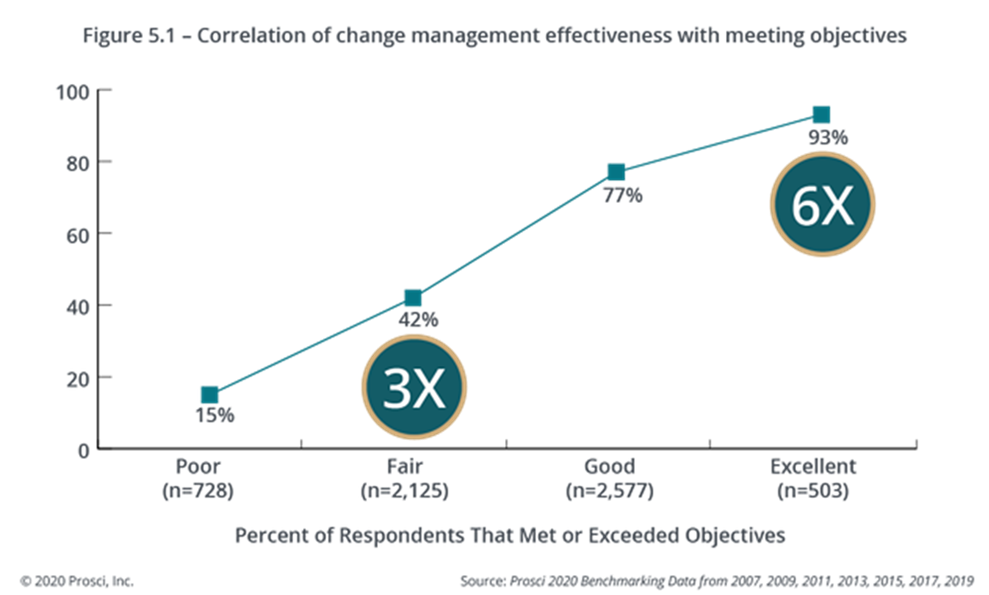
In the graph above, the data points represent the percentage of participants who met or exceeded objectives in each of the change management effectiveness categories (poor, fair, good, and excellent). This data from over 2,700 change practitioners showed that projects with “excellent” change management in place were 6x more likely to meet objectives than those with “poor” change management – and even those using “good” change management were 5x more likely to meet objectives. It’s clear that the more effective change can be managed on a project, the more successful that project can be.
Faster Implementation
It can be challenging for project leaders to understand why change management is important because they have deadlines to manage. It is often perceived that OCM will add more work activities to an already tight schedule and overextend the project timeline. However, based on extensive research from Prosci and other sources, this is not the case.
The image below shows the correlation between change management effectiveness and the ability to stay on or ahead of schedule. Again, the data shows a direct correlation: the more effectively the people side of change is managed, the more likely you are to finish on time. This may sound counterintuitive because on paper, you’re actually adding to the cost by adding an investment of time in change management upfront. However, the data plainly shows that organizations can implement a technology or regulatory compliance transformation a lot faster and cheaper using organizational change management.
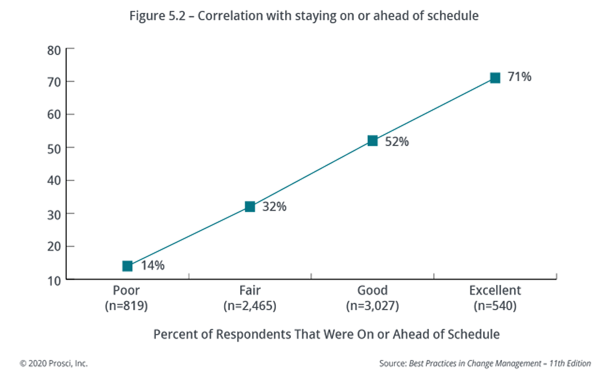
Staying on Budget
A project sponsor (or executive) may understand why OCM is important, but they may not have the budget to dedicate to the people aspects of the change. Certainly, project managers must be attentive to budget constraints, and there are costs to assigning resources to OCM. However, the data below clearly shows that projects with effective OCM are in fact more likely to remain on budget than those with poor OCM. There is clearly a definite connection between the effectiveness of OCM and the ability to keep a project on budget.
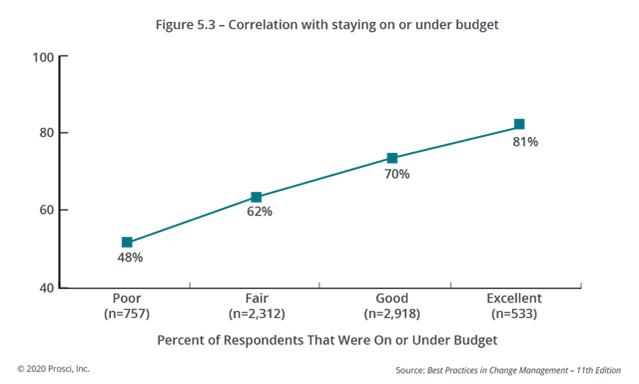
These 3 factors that Prosci surveyed and quantified, show a direct correlation with OCM effectiveness. This can be valuable information to business and project leaders when developing a scope of work for a technology implementation. When the people side of change is NOT managed, the chances of bringing in a project on-time is only 16%, on-budget is only 51%, and the possibility of a project meeting ‘its’ objectives is only 16%. These ‘aren’t acceptable or sustainable metrics in any organization – thus adding a robust OCM program to the project clearly improves outcomes.
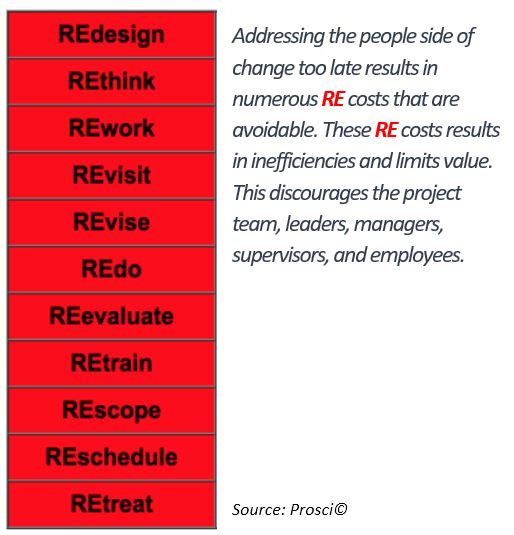
‘It’s worth noting here that if a project is not obtaining the anticipated level of success (on-budget, on-time, objectives met) there is a higher potential for the project to have required rework. This drives up project costs and affects the overall timeline. By proactively developing and deploying an effective OCM strategy, the rework costs can be avoided or mitigated. For example, not collaboratively mapping current or future state workflows with appropriate stakeholders (those who actually do the work) could create a situation where user acceptance testing fails, which in turn would require some of the technical architecture to be redesigned: More Rework = More Costs.
V. Cost avoidance
Projects incur significant and quantifiable costs when changes are not managed properly. In addition to the extra costs of fixing the people-side issues that creep up without OCM, the organization also fails to achieve the anticipated value from the project. Change management is an effective cost avoidance technique we can apply on our projects. Below are just some of the costs that need to be quantified in order to be avoided.
Costs to the ORGANIZATION if Changes are not Managed:
- Productivity plunges
- Impact on customers
- Loss of valued employees
- Morale declines (due to stress, confusion, fatigue)
- Quality of work decline
- Resistance (both active and passive)
- Change saturation occurs
Costs to the PROJECT if Changes are not Managed:
- Project delays and missed milestones
- Project put on hold
- Lack of resources
- Budget overruns
- Rework required on project design
- Project fails to deliver on objectives
- Loss of work by project team
Costs if the Changes are NOT FULLY IMPLEMENTED:
- Expenses not reduced
- Efficiencies not gained
- Revenue not increased
- Market share not gained
- Waste not eliminated
- Regulations not met, resulting in fines/penalties, etc.
When discussing the value of change management, a cost-benefit analysis can be a powerful framework for leadership. We need to know our audience and select the benefit perspectives that will be the most effective. Focusing on the concerns of the audience and connecting the change management to project success by picking the right mix of tools, you can select the most compelling benefit perspectives and work to make them as specific to your change as possible. The right benefits in a cost-benefit analysis can “tip the scale” towards helping leaders realize that investing in OCM is critical for project success.
Clearly, when the project does not deliver expected results (it’s usually a spectrum of failed delivery), the organization loses a lot, or all of the investment made in the project. If you can’t map assets, reconcile as-builts in the field, or get the information you need to run your utility, there’s a huge amount of value that’s lost. Continuing to deploy projects without an OCM strategy is not a profitable way to do business and in order to deliver loyalty-creating customer experiences in today’s environment, organizations need to change the way they do business.
Stay tuned for Part III of this blog series, in which we will examine the Cost Aspect of this Framework to determine the ROI of applying OCM to a project.
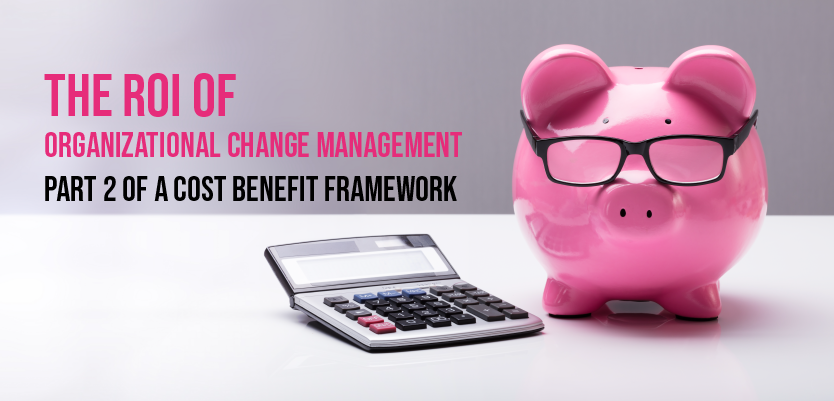

What do you think?